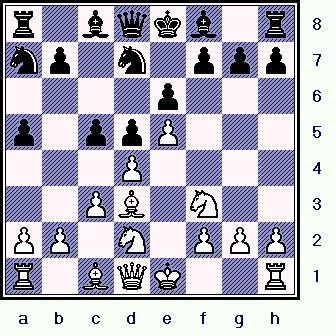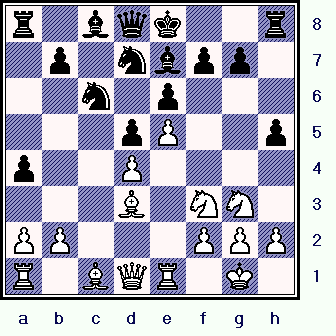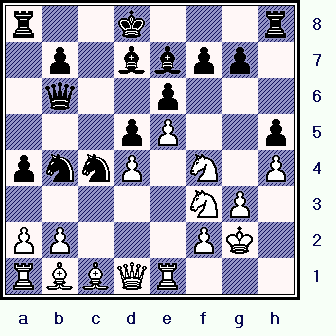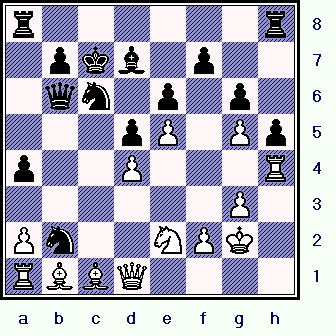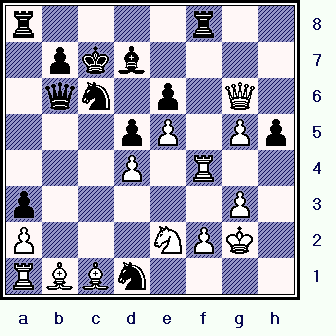All
the |
(Navigation bar
directly below.)
*******
© A.J. Goldsby, 2015.
(All rights reserved.)
****************
Click HERE
to see my
Chess Items.
****************
****************
Buy a book
from Amazon.com
(And help me out as well!)
****************
Click HERE
...
to see a list of the businesses that help to sponsor all of
my chess efforts.
Interesting games ... en passant |
"The curious case of Vlatko Kovacevic's analysis, and the move that he missed..."
Click HERE to see an explanation of the symbols that I commonly use when I annotate any chess game.
Click HERE to replay this game ... on another server.
GM Evgenij Ermenkov (2465) -
GM Vlatko Kovacevic (2530)
|
|
|
r1bqkb1r/np1n1ppp/4p3/p1ppP3/3P4/2PB1N2/PP1N1PPP/R1BQK2R w
Now I would have been tempted to play 9.a3, highlighting the plight of Black's Knights.
9.0-0
Nc6;
(A new move?)
This move was actually a TN at the time it was played.
(See the Informant {# 50} for more details.)
10.Re1 cxd4;
11.cxd4 a4!?; 12.Nf1 Be7; 13.Ng3 h5!?; hmmm
{Diagram.}
This is one of those positions where if Black HAD castled, he might have quickly become
the victim of a brilliancy. (One
example.)
|
|
r1bqk2r/1p1nbpp1/2n1p3/3pP2p/p2P4/3B1NN1/PP3PPP/R1BQR1K1 w
This is an unusual position ... ... ... to say the very least.
(Ultra-modern chess? ---> Black has advanced BOTH of his Rook-Pawns!)
[ Or 13...0-0; 14.a3, "+/=" and White is solidly better here. ]
(Now White's Knight has to move ...
yet again = four whole tempi ...
just to reach e2!)
14.Ne2 Nb6; 15.g3!? Nb4;
Forcing White back.
(The GM -who is playing Black - awards himself an exclam for this move.)
[ The move 15...g5!?; was interesting here. ]
Now in order to pressure the light
squares, White feels that he must maintain his King's Bishop at any cost.
16.Bb1 Bd7; 17.h4 Nc4;
Taking the outpost is good, and pushing the Pawn to a3 was (also) worth consideration.
18.Nf4, (Now the count is five!)
As Black has not yet castled,
this piece of K-side aggression
looks a little pointless.
[ The play of
18.a3!? "="
here, (kicking back one of Black's Knights); looked
like a wise
precaution. ]
18...Qb6;
19.Kg2 Kd8!?; ('!')
{Diagram.}
Black is attempting to get his
King to a safer place, i.e., "castle by hand."
|
|
r2k3r/1p1bbpp1/1q2p3/3pP2p/pnnP1N1P/5NP1/PP3PK1/RBBQR3 w
The game ... and the positions on the chess board ... just get weirder and stranger, move by move.
[ The box's suggestion of: 19...Bb5!?; might have been a fuzz better. ]
Now the natural a2-a3 looks good for White. But, for some unknown reason, Ermenkov seems adverse to playing that move in this encounter.
(Perhaps he is worried about the
"hole" on b3 that the move 20.a3
will create?)
20.Ng5 Bxg5; 21.hxg5 g6!?;
I am not sure if fixing the King-side Pawns is really in Black's best interests.
[ After the moves of:
21...Kc7;
22.g6 fxg6; 23.Nxg6 Rhc8; 24.Rh1, "~" (unclear)
White could be a little better. ]
22.Ne2 Nc6;
Now 22...Kc7; seemed more to the point.
Now Fritz likes Bd3 in this position, but the move played in not bad.
23.Rh1!? Kc7; ('!')
24.Rh4,
Looks maybe a tad premature, it did not appear if Black's pushing his h-Pawn would be that big a deal. (Maybe all White wanted to do was to protect his
QP ... here, in this position?)
[ Maybe slightly better was:
(>/=)
24.Bd3!? Nb4; 25.b3, "+/="
{Diagram?}
(To break the bind on the Q-side ... and maybe open some lines to the Black King.)
]
24...Nxb2; {Diagram.}
Black's last move was probably best, now Fritz is showing a small
(but solid) edge for White.
|
|
r6r/1pkb1p2/1qn1p1p1/3pP1Pp/p2P3R/6P1/Pn2NPK1/RBBQ4 w
It is still a very wild position, take a look for yourself. Which side would you rather play here?
25.Qd2!?,
(Maybe dubious.)
This looks a little vague.
[ >/= 25.Bxb2 Qxb2; 26.Bd3, "+/=" ]
25...a3;
26.Qf4!? Rhc8?!;
This looks wrong, why not just protect the Pawn? (...Rhf8.)
[ But ... '!' - GM V. Kovacevic. ]
[ (or) Maybe >/= 26...Qb4, "=/+" (Fritz) ]
27.Qxf7 Rf8;
28.Qxg6!?, ('?!' / '?')
Too greedy. (The text leaves the Black Rook on the key f-line.)
[ A major improvement would have
been:
>/= 28.Qg7!
Rg8; 29.Qh7 Rh8!?; 30.Qxg6 Rag8!?;
31.Qc2, '±'
(White is much better here, if
not just winning outright.) ]
28...Nd1!?;
(Maybe - '!')
The best try?
29.Rf4?,
{Diagram.}
White makes a routine move ...
and pays the penalty. (The first player had to put his Knight or Bishop on f4 instead. Or - Ermenkov
should have considered 29.Qc2 as another possible playable alternative.
It turns out that - after studying the Informant - that 29.Qc2 was the move that GM Vlatko Kovacevic
{also} examined here. (But in the end, GM V. Kovacevic concluded,
perhaps incorrectly, that White's best move was >/=
29.Bc2.) [See Informant # 50 for that
particular analysis ]
|
|
r4r2/1pkb4/1qn1p1Q1/3pP1Pp/3P1R2/p5P1/P3NPK1/RBBn4 b
This is the current state of things. (On the chess board.)
Now Black finds a shot ... a move that looks completely impossible at first. (Easily worth the two exclams
that I have awarded it here.)
29...Qb2!! ; 30.Bc2?! , (Possibly - '?')
White was already in a very difficult situation, but this move did not help to improve his situation at all.
Editor's note: Now the amazing thing is that the kibitzer's (at ChessGames.com) found a move ... that many titled players MISSED when this game was first played, (and published)! 30.Qc2 is much better than the move actually played!! I think that Black still comes out on top, the collective opinion of the kibitzer's is that White may {yet} hold the balance. (The jury is still out on this one.) Nonetheless, it is still an unusual and exciting discovery.
[ Better was: >/= 30.Qc2! Rxf4!;
(Maybe a double-exclam, Black leaves the Queen hanging for just
one more move.)********************************************************************************
( Probably less accurate was:
</= 30...Qxa1!?; ('?!') 31.Bxa3 Rxa3!;
This looks best/forced, I would be very leery of allowing White
to sink his Bishop into the d6-square here.32.Rxf8 Nc3; This seems like the most logical try for Black.
( Or ("=") 32...Re3!?; 33.g6!, '±' seems to also favor White. )
33.g6!?, (Maybe - '!') {D?} This looks like the sharpest try.
(Also interesting was: 33.Qc1, These lines might have some
independent significance, but for the most part, it will probably
transpose into the variations that begin with 30...Qxa1.)33...Nxe2, Now Black could be struggling to keep his head above water.
(Not so great was: </= 33...Qxb1?!; 34.Qxb1 Nxb1; 35.g7 Ne7;
36.Nf4 Rxa2!?; 37.Nxh5 Nd2; 38.Rf7 Ng8; 39.Nf6, "+/-" {D?}
and it looks like White is winning in this position.)34.g7 Nexd4; 35.Qh7, This looks best for White.
( </= 35.g8Q? Nxc2; 36.Bxc2 Rxa2; 37.Bb3 Rb2; "-/+" )
35...Ne7; 36.Rf7 Qc3!; "~" We now have a rather unclear position
that may even {slightly} favor White. (With 37.Bd3!?, next?)( After the following moves: 36...Qc3!; 37.g8Q Nxg8;
38.Rxd7+ Kc8; 39.Bd3 Qxd3!; 40.Rc7+ Kb8; 41.Rxb7+,
41...Ka8!?; (The only way to continue, otherwise it is a draw.)42.Ra7+ Rxa7; 43.Qxd3 Nc6; 44.Qf3 Nge7; 45.Qxh5 Rxa2;
46.Qe8+ Kb7; 47.Qd7+ Kb6; 48.Kf1 Ra7; 49.Qxe6 Ra1+;
50.Kg2 Ra2; "~" {Equality?} {Diagram?}
we reach an odd position with an extremely unusual material
balance. (Black has a Pawn, two Knights, and a Rook; while
White has a Queen and three nice Pawns.)I tested this situation on both Fritz 9 and ChessMaster 10th
Edition, and both programs considered the game to be a
completely balanced. An early version of Crafty preferred
Black's position, but lost when it allowed Fritz 8 to get White's
Pawns rolling up the board. (Is this a draw?) ) )********************************************************************************
31.Bxf4, This is probably best.
*******
a). Even worse was:
</= 31.Bxb2? Rxf2+; 32.Kg1 Raf8!; 33.Bxa3?,
(Fritz shows White had to play the ugly Nf4 here.)
33...Rf1+; 34.Kg2 R8f2+;
Black could win back the Queen with a Knight fork
on e3 ... but he is after bigger game.
35.Kh3 Rh1#.b). Or RV's line: (</=) 31.Qxd1!? Rxf2+!; 32.Kxf2 Qxa1;
33.Qc2, This is probably best.( </= 33.Qd3?! b5!; 34.g6 b4; "=/+"
Now Black's Queen can escape via the c3-square,
and White is unable to play Bc3. (Moves like
34...Ne7 and 35...Ba4; followed by pushing ...b4-b3
cannot be prevented.) )33...b6!; (tempo) 34.Kg2,
Getting the King to a slightly safer square, several programs
favor this move for White.(</= 34.g6?! Kb7!; The other main point of the Pawn move
{one move earlier} has been revealed, Black's King has a
new {and slightly safer} home.35.Qd3!? Rf8+!; 36.Kg2 Be8; 37.Qxa3 Qxb1; 38.Qxf8,
38...Bxg6; and Black is solidly better ("/+") here.)34...b5; 35.Bd2 Qb2; 36.Qxb2 axb2; 37.Bc3 Rg8; "=/+"
Fritz 9 - after 30 minutes - gives Black over half a Pawn's worth
of an edge, (-0.68); and I would have to agree with that. {A.J.G.}*******
31...Nxf2!; 32.Kxf2 Qxa1; 33.Bd2 Rf8+; 34.Ke1 Qb2; 35.Qxb2,
35...axb2; 36.Bc3, "~" (compensation) {Diagram?}
when White has good play for the material, but I have a feeling that
Black's exchange should eventually tell - in Black's favor.I ran this position past at least half a dozen different chess engines,
ALL of them seemed to favor the second player here.********************************************************************************************
********************************************************************************************
But (of course) not: </= 30.Bxb2? axb2; 31.Qc2 Rxf4; 32.Nxf4,
(</= 32.Qxb2?? Nxb2; "-/+") 32...bxa1Q; 33.Qxd1 Nxd4; "-/+"
with an overwhelming position for the second player. (-5.09) ]
White's game continues to go
downhill, although GM Ermenkov
could have made a fight of it by
exchanging Rooks on f8, (on move thirty-one).
30...Qxa1;
31.Bxd1? Rxf4!; 32.gxf4 Qxa2;
Now Black is winning.
33.f5 Qb1;
34.Nc3 Qxc1; 35.fxe6 Qxc3; 36.exd7 Qxd4;
(More than) Good enough ...
at least, to win the game.
[ Also a possibility was: 36...a2; ('!') "-/+" with an easy win for Black. ]
37.Qd6+ Kb6; 38.e6!? a2; 39.Bf3 Qc5; "-/+" (and) Ermenkov Resigns.
White has had enough ... and throws in the towel.
The tactics - and the positions that are reached! - are much different than in many games of chess. (Wild and wacky chess?)
For more information ... or a
completely different analysis of this intriguing contest, please see
the Informant, # 50 - game # 296.
(Many of Black's moves that have an exclam in parenthesis - is an indication how this game was annotated in
that issue of the Informant.)
Copyright (c) A.J. Goldsby, 2006. All rights reserved.
0 - 1
This analysis was generated on my computer. [specs] I used Fritz 8, Fritz 9, Hiarcs, Deep Junior and I also extensively used the excellent program, ChessMaster 10th Edition, as well. A different/slower computer may yield results that may vary greatly from mine. Please check your results carefully before lambasting me. BUT! Please e-mail if you find any {major} mistakes. (I also did not depend entirely on the computer, at many important junctures, I simply had to make a judgment call ... based on my experience.) I look forward to some healthy debate on these lines! Post any discoveries or interesting variations here, and be sure to e-mail me as well.
May 03, 2006: This game continues to generate much discussion {and deep analysis!!!} on the CG server. While I stand behind all of the above analysis, the general consensus of many of the "kibitzer's" on the CG site is that many of the key lines after 29...Qb2!!; 30.Qc2!, might well end in a draw. I am not so sure, however, and continue to analyze these variants. I am also strongly looking into ... (I tried to order it today) ... the possibility of obtaining the "Rybka" program. Maybe when I have the program on my own, I can look at a few of these lines and reach some kind of firm decision. (Stay tuned.)
The analysis for this page was prepared with the excellent program, ChessBase 9.0.
The HTML was polished with several different tools and programs, (mostly FP) ... the text was checked for spelling with MS Word.
The diagrams were created with the program, Chess Captor 2.25.
|
Go ... or return ... to my Home Page for this site. Go (or return) ... to my "Annotated Games" (II) Page. Go
... or return ... to my "Best Games" Page. *******
Copyright (c)
LM A.J. Goldsby
I ******* This page was first generated in: April, 2006. (Posted on: Tuesday; April 18th, 2006.) This game was last edited, altered or saved on: July 14, 2012 02:16 AM . |
